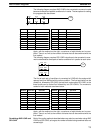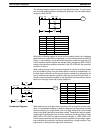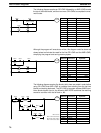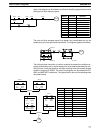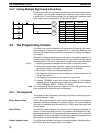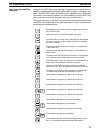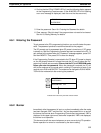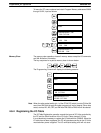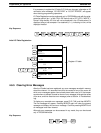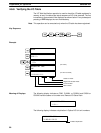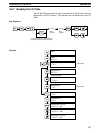
!
!
80
4-5-2 PC Modes
The Programming Console is equipped with a switch to control the PC mode. To
select one of the three operating modes—RUN, MONITOR, or PROGRAM—
use the mode switch. The mode that you select will determine PC operation as
well as the procedures that are possible from the Programming Console.
RUN mode is the mode used for normal program execution. When the switch is
set to RUN and the START input on the CPU Power Supply Unit is ON, the CPU
will begin executing the program according to the program written in its Program
Memory. Although monitoring PC operation from the Programming Console is
possible in RUN mode, no data in any of the memory areas can be input or
changed.
MONITOR mode allows you to visually monitor in-progress program execution
while controlling I/O status, changing PV (present values) or SV (set values),
etc. In MONITOR mode, I/O processing is handled in the same way as in RUN
mode. MONITOR mode is generally used for trial system operation and final pro-
gram adjustments.
In PROGRAM mode, the PC does not execute the program. PROGRAM mode
is for creating and changing programs, clearing memory areas, and registering
and changing the I/O table. A special Debug operation is also available within
PROGRAM mode that enables checking a program for correct execution before
trial operation of the system.
DANGER Do not leave the Programming Console connected to the PC by an extension cable when in
RUN mode. Noise picked up by the extension cable can enter the PC, affecting the program
and thus the controlled system.
4-5-3 The Display Message Switch
Pin 3 of the CPU’s DIP switch determines whether Japanese or English lan-
guage messages will be displayed on the Programming Console. It is factory set
to ON, which causes English language messages to be displayed.
4-6 Preparation for Operation
This section describes the procedures required to begin Programming Console
operation. These include password entry, clearing memory, error message
clearing, and I/O table operations. I/O table operations are also necessary at
other times, e.g., when changes are to be made in Units used in the PC configu-
ration.
DANGER Always confirm that the Programming Console is in PROGRAM mode when turning on the
PC with a Programming Console connected unless another mode is desired for a specific
purpose. If the Programming Console is in RUN mode when PC power is turned on, any
program in Program Memory will be executed, possibly causing a PC-controlled system to
begin operation.
The following sequence of operations must be performed before beginning in-
itial program input.
1, 2, 3...
1. Insert the mode key into the Programming Console.
2. Set the mode switch to PROGRAM mode. (The mode key cannot be re-
moved while set to PROGRAM mode.)
3. Turn on PC power.
Note When I/O Units are installed, turn on those Units also. The Program-
ming Console will not operate if these Units are not turned on.
Preparation for Operation Section 4-6




